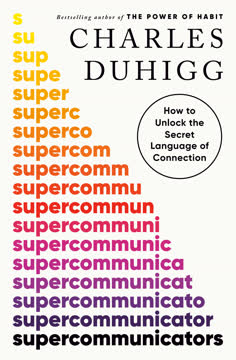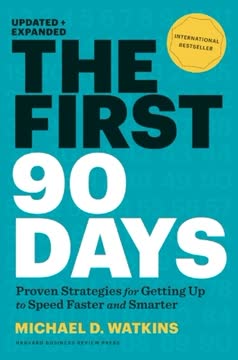Key Takeaways
1. Sponsorship is the key to career advancement, not mentorship
Mentors give, whereas sponsors invest.
Sponsorship vs. mentorship. Mentors provide advice and guidance, but sponsors actively advocate for your career advancement. Sponsors are senior leaders who use their influence to help you get promoted, land key assignments, and increase your visibility within the organization. Unlike mentors, sponsors take a stake in your success because it reflects on their own reputation and legacy.
Impact of sponsorship. Research shows that employees with sponsors are:
- 23% more likely to advance in their careers than those without
- 19% more likely to be satisfied with their rate of advancement
- 27% more likely to stay in their jobs if they're working mothers
2. Sponsors provide advocacy, opportunity, and air cover
Sponsors do three things that mentors do not.
Key sponsor actions. Effective sponsors:
- Advocate for your next promotion
- Provide stretch opportunities
- Give "air cover" so you can take risks
Beyond mentorship. Sponsors go further by:
- Connecting you to senior leaders and key clients
- Boosting your visibility in the company
- Giving honest, critical feedback on skill gaps
- Advising on your "presentation of self"
Sponsors invest in your success because you're an extension of their brand and vision. They see furthering your career as an important investment in their own legacy and organization.
3. Attract sponsors by delivering exceptional performance and loyalty
Protégés attract sponsors by delivering in exceptional ways and secure sponsorship by remaining utterly devoted, even as they distinguish themselves as stars in their own right.
Performance. To attract sponsors:
- Consistently exceed expectations
- Hit targets and deadlines
- Display an impressive work ethic
Loyalty. To keep sponsors:
- Demonstrate trustworthiness and discretion
- Have your sponsor's back
- Promote their legacy
- Burnish their brand across the organization
Reciprocity. Sponsorship is a two-way street. Protégés must deliver value to their sponsors, not just receive benefits. This might involve providing unique insights, complementary skills, or access to new markets or networks that the sponsor lacks.
4. Develop and deploy your unique currency to stand out
You absolutely have an important piece of value to leverage. You just may not be projecting it.
Identify your currency. Reflect on:
- How you're innately different from peers
- Unique aspects of your background or experience
- Distinctive skill sets or approaches to problem-solving
- Cultural insights or connections you bring
Deploy strategically. Use your currency to:
- Solve problems or innovate in ways others can't
- Access untapped markets or customer bases
- Provide valuable perspectives in team discussions
- Reverse-mentor leaders in areas where you have expertise
Stand out authentically. Your "outsider" status or what brands you as different might actually be your most valuable asset. Don't hide it – learn to leverage it strategically to differentiate yourself and provide unique value to your organization and sponsors.
5. Lead with a "yes" and negotiate details later
Just say yes. Hold back on sharing your reservations until you're in a position to negotiate.
Lean in. When offered opportunities:
- Show enthusiasm and gratitude first
- Convey confidence in your ability to deliver
- Save caveats and conditions for later discussions
Attitude matters. Research shows:
- 57% of sponsors value a can-do attitude in protégés
- Only 32% of protégés say they "lead with a yes"
Strategic acceptance. If you must qualify your "yes":
- Reiterate your enthusiasm for the opportunity
- Explain your confidence in getting the job done
- Propose solutions to potential obstacles, don't just present problems
- Negotiate for the support you'll need to succeed
By leading with positivity and problem-solving, you demonstrate your commitment and readiness for greater responsibility.
6. Navigate the pitfalls of sex, distrust, and executive presence
Sex—the fact of it, the illusion of it—is the third rail for professional men and women.
Sexual dynamics. To avoid misperceptions:
- Relentlessly telegraph professionalism
- Meet sponsors in public settings
- Be upfront about personal commitments
- Introduce your spouse/partner to sponsors
Racial distrust. For professionals of color:
- Master social banter to build connections
- Draw on your background to drive business value
- Propose projects that position you as a problem-solver
- Dare to ask for help when needed
Executive presence. Focus on three key areas:
- Gravitas: Exude confidence, integrity, and grace under pressure
- Communication: Speak with clarity, concision, and appropriate tone
- Appearance: Look polished and appropriate for your environment
Navigating these pitfalls requires awareness, strategic action, and continuous self-improvement.
7. Cultivate multiple sponsors to distribute career risk
The ideal life raft in larger organizations, CTI research shows, consists of three sponsors: two within your organization—one in your line of sight and one in a different department or division—and one outside your firm.
The 2+1 Rule. Aim for:
- 2 sponsors within your organization
- 1 sponsor outside your firm
Diversify your portfolio. Ensure sponsors are:
- Independent of each other
- From different areas of the organization
- Able to provide varied perspectives and opportunities
Build your network. To increase visibility:
- Lead employee resource groups or affinity networks
- Spearhead philanthropic projects or company events
- Join nonprofit boards relevant to your industry
- Speak at conferences or professional associations
By cultivating multiple sponsors, you create a safety net for your career, protecting against leadership changes, restructurings, or industry shifts.
8. Embrace your dream and do a career diagnostic
Without a clear sense of your destination, there's no point in getting yourself a sponsor. Sponsors are the dream enablers.
Dream big. Reflect on:
- What place would feel magical to work in?
- Whom do you want to meet and work with?
- What transformation do you want to drive?
Self-assessment. Take stock of:
- Your exceptional skills and experiences
- Your unique "currency" or differentiators
- Accomplishments that have given you joy and recognition
- How your goals align with your organization's mission
Organizational landscape. Understand:
- Your firm's structure (flat or hierarchical)
- What deliverables lead to promotion
- Potential career plateaus or pitfalls to navigate
This clarity of vision and self-awareness will help you attract and leverage sponsors effectively.
9. Seek sponsors with influence, not just affinity
Put efficacy over affinity. Role models are great to have, but they may not make effective sponsors.
Target power players. Look for sponsors who:
- Have a voice at decision-making tables
- Are two levels above you in large organizations
- Have the ear of founders/leaders in smaller firms
Broaden your search. Don't limit yourself to:
- Only those with similar backgrounds or styles
- Mentors or role models without real influence
- Friends or close colleagues
Get noticed. To attract potential sponsors:
- Ask for stretch assignments in their line of sight
- Attend events where you can introduce yourself
- Propose collaborating on projects of interest to them
- Articulate your unique value proposition clearly
Remember, you need respect and trust with a sponsor, not necessarily personal affinity or friendship.
10. Overcome distrust and bias through proactive relationship-building
Distrust is a self-fulfilling prophecy: minority professionals who distrust those in power effectively deny themselves the support they need to realize their leadership potential, further reinforcing their conviction that leadership at their company isn't interested in people of color.
Build connections. Strategies for professionals of color:
- Master social banter on topics like sports or current events
- Join company sports teams or social activities
- Share aspects of your culture that add value to the business
- Propose innovative projects that showcase your skills
Address bias head-on. When passed over:
- Ask for specific feedback on areas for improvement
- Don't assume race is the issue without evidence
- Demonstrate your value through measurable results
Leverage your difference. Use your unique perspective to:
- Access untapped markets or customer insights
- Bring fresh approaches to problem-solving
- Enhance team diversity and creativity
By actively building relationships and demonstrating your value, you can overcome barriers of distrust and create powerful alliances.
11. Master the elements of executive presence: gravitas, communication, and appearance
No man or woman attains power or exerts influence without it—executive presence (EP), that aura of confidence and competence that convinces others that you deserve to be in charge.
Gravitas (67% of EP). Key aspects:
- Grace under fire
- Decisiveness and confidence
- Integrity and authenticity
Communication (28% of EP). Focus on:
- Speaking with an appropriate tone and pace
- Concise, impactful messaging
- Mastering small talk and building rapport
Appearance (5% of EP). Ensure you:
- Look polished and appropriate for your environment
- Align your style with successful leaders in your industry
- Express authenticity within professional boundaries
Continuous improvement. To enhance your EP:
- Seek honest feedback from sponsors and colleagues
- Observe and emulate effective leaders in your organization
- Practice communicating with clarity and confidence
- Invest in your personal presentation and grooming
Developing strong executive presence is crucial for being perceived as leadership material and accessing opportunities for advancement.
Last updated:
FAQ
What's "Forget a Mentor, Find a Sponsor" about?
- Focus on Sponsorship: The book emphasizes the importance of finding a sponsor rather than just a mentor to fast-track one's career. Sponsors are individuals who have the power to advocate for you and help you advance professionally.
- Career Advancement Strategy: It provides a strategic approach to career development, highlighting how sponsorship can lead to promotions, pay raises, and high-profile assignments.
- Gender and Diversity Lens: The book addresses the unique challenges faced by women and minorities in the workplace and how sponsorship can help overcome these barriers.
- Practical Guidance: It offers actionable advice and a roadmap for both protégés seeking sponsors and sponsors looking to support high-potential talent.
Why should I read "Forget a Mentor, Find a Sponsor"?
- Career Growth: If you're looking to accelerate your career, this book provides insights into how sponsorship can be a game-changer.
- Data-Driven Insights: The book is backed by research and data, offering evidence-based strategies for career advancement.
- Diverse Perspectives: It includes stories and advice from successful leaders across various industries, providing a broad perspective on the power of sponsorship.
- Actionable Advice: The book offers practical steps and strategies that you can implement to find and maintain a sponsor relationship.
What are the key takeaways of "Forget a Mentor, Find a Sponsor"?
- Sponsorship vs. Mentorship: Sponsors invest in your career and advocate for you, while mentors provide advice and guidance.
- Reciprocal Relationship: Sponsorship is a two-way street where both parties benefit; protégés must deliver results and loyalty.
- Diversity and Inclusion: Sponsorship is crucial for women and minorities to break through barriers and achieve leadership roles.
- Strategic Networking: Building a network of sponsors, both within and outside your organization, is essential for career resilience.
How does Sylvia Ann Hewlett define sponsorship in the book?
- Advocacy and Influence: A sponsor is someone who believes in your value and potential and is willing to advocate for you at decision-making tables.
- Career Advancement: Sponsors help you get promotions, pay raises, and high-profile assignments by leveraging their influence.
- Risk and Reward: They provide air cover, allowing you to take risks and innovate without fear of failure.
- Mutual Investment: Sponsorship is a strategic alliance where both the sponsor and protégé invest in each other's success.
What are the best quotes from "Forget a Mentor, Find a Sponsor" and what do they mean?
- "A mentor gives you advice about how to get ahead. A sponsor has power and uses it to get you a great assignment." This quote highlights the fundamental difference between mentorship and sponsorship, emphasizing the active role sponsors play in career advancement.
- "Women are often overmentored and undersponsored." This quote points out a common issue where women receive plenty of advice but lack the advocacy needed to reach leadership positions.
- "Sponsorship isn’t favoritism or politics; it doesn’t rig the game. On the contrary, it ensures you get what you’ve worked for and deserve." This quote clarifies that sponsorship is about recognizing and rewarding talent and hard work, not about unfair advantages.
How can I find a sponsor according to "Forget a Mentor, Find a Sponsor"?
- Identify Potential Sponsors: Look for leaders who are aware of your skills, stand to benefit from your help, and have the clout to advance your career.
- Demonstrate Value: Show what makes you worth sponsoring by highlighting your unique skills and contributions.
- Propose a Quid Pro Quo: Clearly articulate what you can offer your sponsor and what you hope to gain in return.
- Build a Network: Cultivate relationships with multiple sponsors to distribute risk and ensure career resilience.
What is the "2 + 1 Rule" mentioned in the book?
- Diversified Sponsorship: The "2 + 1 Rule" suggests having two sponsors within your organization and one outside to ensure career stability.
- Internal Sponsors: One sponsor should be in your line of sight, and another in a different department or division to provide broader support.
- External Sponsor: An external sponsor can offer opportunities and insights beyond your current organization.
- Risk Management: This approach helps protect your career from organizational changes and leadership churn.
How does the book address the challenges faced by women and minorities in the workplace?
- Barriers to Advancement: The book discusses the unique challenges women and minorities face, such as bias and lack of access to influential networks.
- Importance of Sponsorship: It emphasizes that sponsorship is crucial for overcoming these barriers and achieving leadership roles.
- Diverse Stories: The book includes stories from successful women and minority leaders, providing insights into how they navigated their careers.
- Actionable Strategies: It offers specific strategies for women and minorities to find sponsors and leverage these relationships for career growth.
What role does executive presence play in sponsorship according to the book?
- Definition of Executive Presence: Executive presence is the combination of gravitas, communication skills, and appearance that signals leadership potential.
- Importance for Sponsorship: Having executive presence makes you more likely to attract and retain sponsors, as it demonstrates your readiness for leadership.
- Feedback and Improvement: The book stresses the importance of seeking feedback to develop executive presence and align it with organizational expectations.
- Cultural Considerations: It acknowledges that executive presence can be culturally specific and offers guidance on navigating these nuances.
How does Sylvia Ann Hewlett suggest handling the potential pitfalls of sponsorship?
- Avoiding Misconceptions: Be aware of the potential for sponsorship relationships to be misconstrued, especially between men and women.
- Professional Boundaries: Maintain professionalism in all interactions and be transparent about your career goals and personal commitments.
- Addressing Distrust: For minorities, it's important to overcome distrust and actively seek sponsorship from leaders of all backgrounds.
- Navigating Executive Presence: Be mindful of how you present yourself and seek feedback to ensure your executive presence aligns with leadership expectations.
What are some practical steps for protégés to take in leveraging sponsorship?
- Deliver Results: Consistently perform at a high level and demonstrate your value to the organization.
- Communicate Effectively: Keep your sponsor informed about your progress and any challenges you face.
- Show Loyalty: Be a reliable and trustworthy ally to your sponsor, supporting their goals and initiatives.
- Develop Unique Skills: Identify and cultivate skills that set you apart and make you indispensable to your sponsor.
How does "Forget a Mentor, Find a Sponsor" redefine traditional career development?
- Shift from Mentorship to Sponsorship: The book challenges the traditional focus on mentorship by highlighting the greater impact of sponsorship on career advancement.
- Transactional Relationships: It redefines career development as a strategic, reciprocal relationship where both parties invest in each other's success.
- Focus on Results: The book emphasizes the importance of delivering tangible results and building a personal brand to attract sponsors.
- Inclusive Leadership: It advocates for a more inclusive approach to leadership development, recognizing the diverse talents and contributions of women and minorities.
Review Summary
Forget a mentor, find a sponsor received mixed reviews, with an average rating of 3.73/5. Readers appreciated the distinction between mentors and sponsors, finding value in the advice on career advancement through sponsorship. However, some criticized the book for promoting elitist views and focusing too much on appearance. Many found it insightful for navigating corporate environments, while others felt it encouraged an overly transactional approach to relationships. The book's controversial nature sparked debate about its applicability and ethical implications in the workplace.
Similar Books










Download PDF
Download EPUB
.epub digital book format is ideal for reading ebooks on phones, tablets, and e-readers.





